| |
Life expectancy estimates based on comorbidities and frailty to inform preventive care
|
| |
| |
-----------------------------
Download the PDF here
in a separate study reported at Glasgow 2018:
Multimorbidity and risk of death differs by gender in people living with HIV in the Netherlands - the ATHENA cohort study
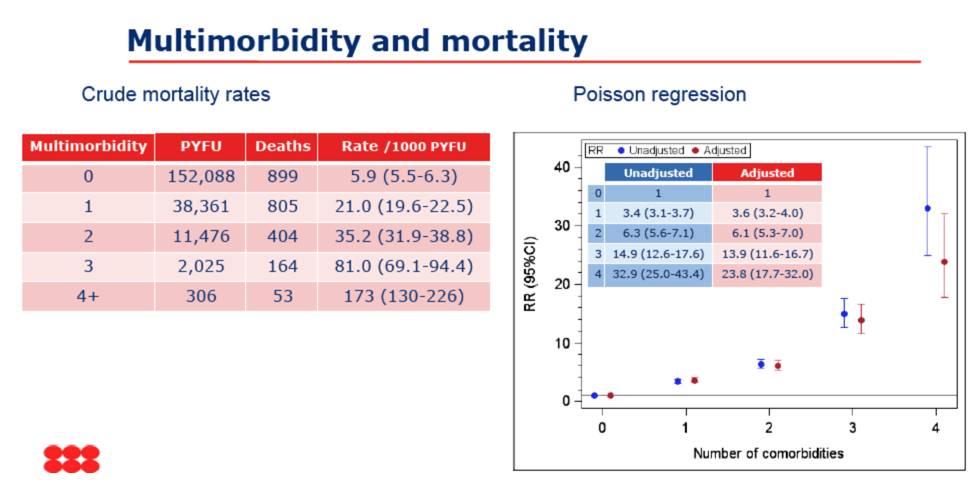
-------------------------------------------
We incorporated both comorbidities and frailty to estimate 5- and 10-year survival probabilities and median life expectancies for adults aged 66-95 years. Although a few previous studies compared the discriminative ability of comorbidities and frailty in mortality prediction, these studies focused on shorter time frames ranging from 1 to 5 years and none focused on incorporating both comorbidities and frailty in life expectancy estimates.29, 37-39 These prior works found that comorbidities and frailty were independent predictors of mortality in the shorter time frames. Our results extend this body of research by showing that for a longer time frame of over 10 years-an important threshold in preventive care decisions for older adults-both comorbidities and frailty remain independent and significant predictors of mortality.
We found that both comorbidities and frailty were independently associated with all-cause mortality in the Cox model, after adjusting for sex, race, year of initial enrollment, and SEER region (Table S3). Having high comorbidities category (HR, 3.24; 95% confidence interval [CI], 3.20-3.28) and low/medium comorbidities category (HR, 1.36; 95% CI, 1.34-1.39) were both associated with higher risks of death than having no comorbidities. Compared to low frailty, high frailty category was associated with a higher risk of death (HR, 1.55; 95% CI, 1.52-1.58).
For example, all adults in our study who had high comorbidities and high frailty had less than 10 years of estimated life expectancy across a wide age range of 66-90 and was true for both males and females.
In summary, frailty adds unique and important information than considering comorbidities alone in the context of long-term prognostication of older adults. This study incorporated frailty in addition to comorbidities in estimating long-term life expectancies of older adults to enhance individualized estimates.
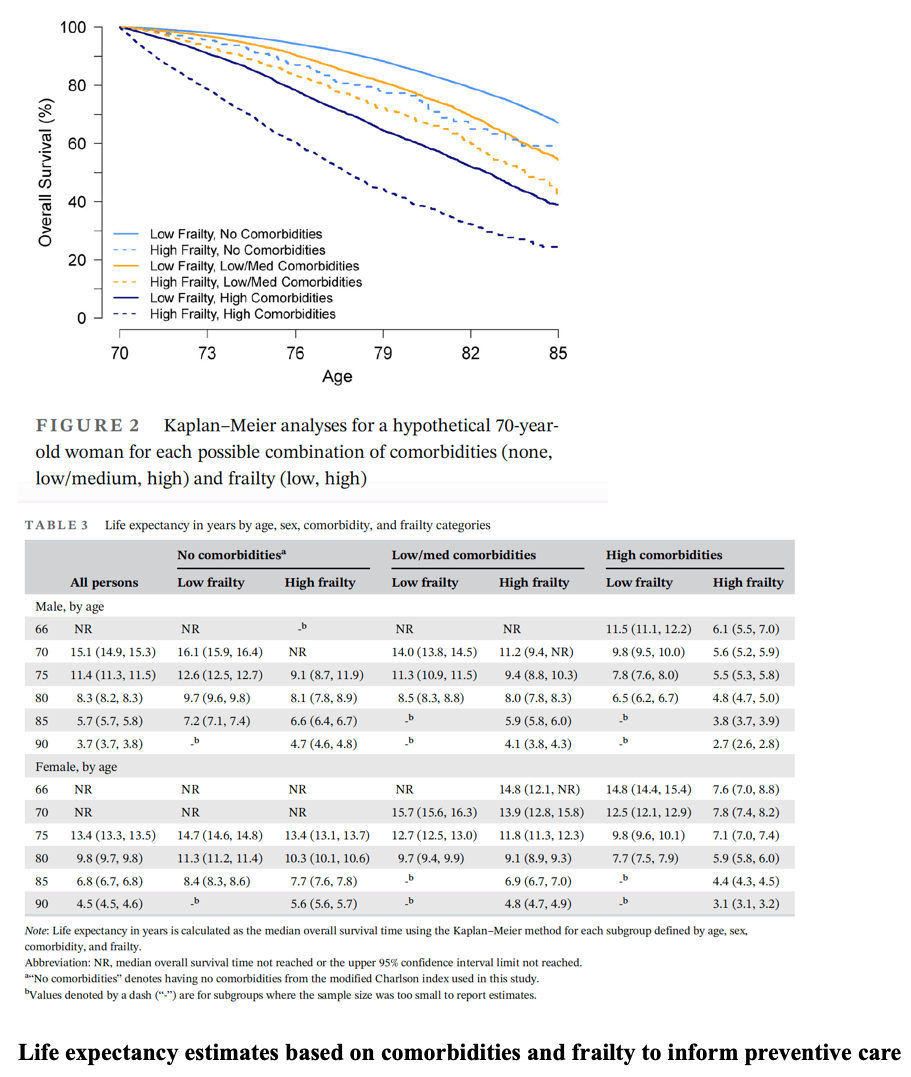
18 September 2021
Abstract
Background
Long-term prognostication is important to inform preventive care in older adults. Existing prediction indices incorporate age and comorbidities. Frailty is another important factor in prognostication. In this project, we aimed at developing life expectancy estimates that incorporate both comorbidities and frailty.
Methods
In this retrospective cohort study, we used data from a 5% sample of Medicare beneficiaries with and without history of cancer from Surveillance, Epidemiology, and End Results (SEER) cancer registry areas. We included adults aged 66-95 years who were continuously enrolled in fee-for-service Medicare for ≥1 year from 1998 to 2014. Participants were followed for survival until 12/31/2015, death, or disenrollment. Comorbidity (none, low/medium, high) and frailty categories (low, high) were defined using established methods for claims. We estimated 5- and 10-year survival probabilities and median life expectancies by age, sex, comorbidities, and frailty.
Results
The study included 479,646 individuals (4,128,316 person-years), of whom most were women (58.7%). Frailty scores varied widely among participants in the same comorbidity category.
In Cox models, both comorbidities and frailty were independent predictors of mortality.
Individuals with high comorbidities (HR, 3.24; 95% CI, 3.20-3.28) and low/medium comorbidities (HR, 1.36; 95% CI, 1.34-1.39) had higher risks of death than those with no comorbidities.
Compared to low frailty, high frailty was associated with higher risk of death (HR, 1.55; 95% CI, 1.52-1.58). Frailty affected life expectancy estimates in ways relevant to preventive care (i.e., distinguishing <10-year versus >10-year life expectancy) in multiple subgroups.
Conclusion
Incorporating both comorbidities and frailty may be important in estimating long-term life expectancies of older adults. Our life expectancy tables can aid clinicians' prognostication and inform simulation models and population health management.
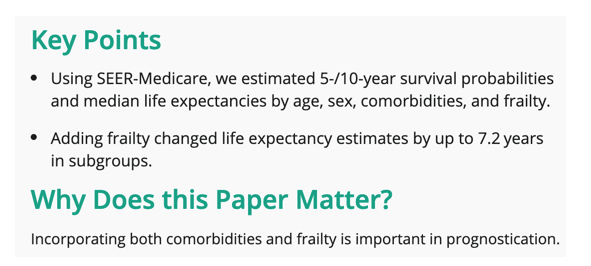
INTRODUCTION
Predicting patients' long-term health trajectories is important to inform preventive care decisions in older adults.1-12 Specifically, a life expectancy of less than 10 years is a commonly used threshold for defining "limited life expectancy" and for de-intensifying certain preventive care tests that have a long lag-time to benefit.5-11 For example, national guidelines recommend against routine screening for breast, colorectal, and prostate cancers in older adults who are expected to live less than 10 years because the short-term harms and burdens of screening outweigh the delayed benefits.5-9 Similarly, guidelines recommend a less intensive glycemic goal for diabetes mellitus treatment in older adults with less than 10-year life expectancy.11, 12
A robust body of evidence suggests that age alone, while important, is an insufficient marker of prognosis in older adults; older adults of the same age can have very heterogeneous health trajectories.3, 13 Literature also suggests that clinicians are uncomfortable with prognostication and often inaccurate in their estimates,14, 15 highlighting the importance of tools that can help estimate life expectancy in older adults. Several predictive algorithms have been developed to predict mortality or life expectancy over 10 or more years in older adults. All of this incorporate information about chronic conditions (we use the term comorbidities in this article) in addition to age to aid in prognostication.1, 16-21
Frailty, a common medical syndrome in older adults associated with decline in reserve and function across multiple physiologic systems, has been shown to be predictive of multiple adverse outcomes including mortality, hospitalization, and institutionalization; it has in particular been highlighted as a significant risk factor during the COVID-19 pandemic.22-26 The physical frailty phenotype characterizes a state of increased vulnerability to stressors resulting from depleted physiologic reserves and is conceptualized as a distinct entity from comorbidities or multimorbidity-the concurrent presence of two or more medically diagnosed diseases.27, 28 Despite evidence suggesting that incorporating both comorbidities and frailty in mortality prediction can be valuable,29 we found no published studies that predicted long-term mortality (greater than 10 years) of older adults while incorporating both comorbidities and frailty. Thus, we aimed at building upon previous work to develop life expectancy estimates that incorporate both comorbidities and frailty status.
Comorbidity status was assessed using the method by Cho et al. using a modified Charlson index.1, 32 We excluded diagnoses on outpatient or physician supplier claims that did not appear more than once over time span exceeding 30 days so as to exclude evaluation of suspected diagnoses.33 After the list of comorbidities were identified in claims using diagnosis codes,32 we assigned a weighted score for each condition using the estimated effect of each condition on survival that has been reported previously (e.g., coefficient of each condition on overall survival in the Cox model). 1 The list of conditions and associated weighted scores are included in Table S1. We summed the individual scores of each condition into a total comorbidity score for each 12-month episode of care. We then classified each episode of care into three comorbidity categories based on the total comorbidity score using the cutpoints established by Cho et al: "no comorbidities" (total score = 0), "low/medium comorbidities" (0 < total score ≤ 0.56), and "high comorbidities" (total score > 0.56).1
Frailty status was assessed using a validated claims-based algorithm that estimates the probability of having the physical frailty phenotype by Segal et al.31 A frailty score ranging from 0 to 1, denoting the probability of having physical frailty phenotype, was calculated for each episode of care. We then classified each episode of care into two frailty categories: We defined "low frailty" as a score of ≤0.15 and "high frailty" as a score > 0.15. To identify the optimal cutoff, we examined different cutoffs of the frailty score at 0.05 intervals and estimated, for each potential cutoff, the hazard ratio (HR) associated with higher frailty on mortality, which was our outcome of interest. We chose the cutoff of 0.15 at which the highest HR was found, suggesting that this cutoff was most able to discriminate the effect of frailty on mortality. The conditions that are used to define frailty are listed in Table S2.
DISCUSSION - extracts
We incorporated both comorbidities and frailty to estimate 5- and 10-year survival probabilities and median life expectancies for adults aged 66-95 years. Although a few previous studies compared the discriminative ability of comorbidities and frailty in mortality prediction, these studies focused on shorter time frames ranging from 1 to 5 years and none focused on incorporating both comorbidities and frailty in life expectancy estimates.29, 37-39 These prior works found that comorbidities and frailty were independent predictors of mortality in the shorter time frames. Our results extend this body of research by showing that for a longer time frame of over 10 years-an important threshold in preventive care decisions for older adults-both comorbidities and frailty remain independent and significant predictors of mortality.
Prior work showed various degrees of overlap between comorbidities and frailty in older adults.28, 29 Our results found that although both comorbidities and frailty increased in prevalence with increasing age, there was significant heterogeneity in the frailty status among participants with the same age and comorbidity status, again highlighting that the two constructs-comorbidities and frailty-although related, capture different information about an individual's health status and health trajectory. Existing literature has found that frailty is an important predictor of multiple adverse outcomes such as institutionalization, hospitalization, and mortality.22-26 We add to this literature to show that frailty, independent of comorbidities, contributed substantially to the estimation of life expectancy in older adults. The higher hazard for mortality associated with frailty found in our study is comparable to what has been previously reported in the literature.25
Our results have several important implications. As clinical practice guidelines increasingly recognize and recommend the consideration of 10-year life expectancy to inform preventive care decisions in older adults,1-12 the results from this project highlight the importance of considering older adults' frailty status in addition to comorbidities in prognostication. For example, all adults in our study who had high comorbidities and high frailty had less than 10 years of estimated life expectancy across a wide age range of 66-90 and was true for both males and females. This could be a rule-of-thumb to consider in clinical practice to inform recommendations about preventive care, especially in the relatively younger patients. Although we organized the life expectancy predictions by comorbidity and frailty categories for ease of interpretation and have provided information for clinicians to assign patients into these categories, we recognize that busy clinicians may not have the time to apply the exact definitions for comorbidity and frailty categories as used in the study, which could be a barrier to use or lead to misclassification errors. One remedy could be to leverage electronic medical records to automatically extract diagnoses, generate estimates of patients' comorbidity and frailty scores and corresponding life expectancies, and link these directly with preventive care reminders or recommendations within the electronic medical record. By incorporating both frailty and comorbidities, our results allow for more individualized estimates of life expectancy to inform preventive care decisions; however, how to best communicate these results directly to patients is beyond the scope of this project and warrants further study. This is an important area as previous studies demonstrated that directly referring to one's limited life expectancy or being frail does not resonate readily with older adults and may have associated negative connotations.40-43
In summary, frailty adds unique and important information than considering comorbidities alone in the context of long-term prognostication of older adults. This study incorporated frailty in addition to comorbidities in estimating long-term life expectancies of older adults to enhance individualized estimates.
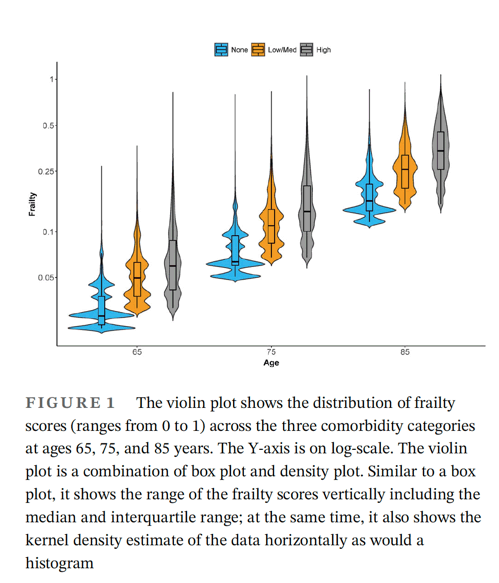
We found that both comorbidities and frailty were independently associated with all-cause mortality in the Cox model, after adjusting for sex, race, year of initial enrollment, and SEER region (Table S3). Having high comorbidities category (HR, 3.24; 95% confidence interval [CI], 3.20-3.28) and low/medium comorbidities category (HR, 1.36; 95% CI, 1.34-1.39) were both associated with higher risks of death than having no comorbidities. Compared to low frailty, high frailty category was associated with a higher risk of death (HR, 1.55; 95% CI, 1.52-1.58).
Table 2 shows the Kaplan-Meier estimates of 5-year and 10-year survival probabilities stratified by age, sex, comorbidity, and frailty categories, with associated sample sizes for each subgroup. Survival probabilities generally decreased with age within each subgroup; for example, 10-year survival probabilities for males with low/medium comorbidities and low frailty ranged from 79% at age 66 to 39% at age 80. Survival probabilities decreased as comorbidities increased and as frailty increased. For example, a 70-year-old male with low/medium comorbidities and low frailty had a 10-year survival probability of 70%. If he were to have high frailty instead of low frailty, the 10-year survival probability is lowered to 55%. If he were to have high comorbidities instead of low/medium comorbidities, the 10-year survival probability is lowered to 48%. The overall survival of our study cohort closely matched that of the U.S. older adults in sensitivity analyses (Figure S2).
The corresponding median life expectancies stratified by age, sex, comorbidity, and frailty categories are shown in Table 3. For some subgroups at younger ages (66 to 70) with no comorbidities or low/medium comorbidities and/or low frailty, survival over the study period was too high to estimate median life expectancies (Not Reached [NR]). The corresponding 5- and 10-year survival probabilities could be used to inform clinical decisions in these cases. Conversely, for certain subgroups at older ages, there was insufficient sample size to make estimates. Within the same comorbidity categories, frailty status (high versus low frailty) changed estimated life expectancies, ranging from 0.4 years for 80-year-old males with low/medium comorbidities to as much as 7.2 years for 66-year-old females with high comorbidities. For a number of these subgroups, the change in estimated life expectancies altered whether the individual would be categorized as having "limited life expectancy" of <10 years versus >10 years and would potentially lead to different preventive care decisions. For example, a 70-year-old female with high comorbidities and low frailty would still have a median life expectancy of 12.5 years, whereas an individual with the same age and comorbidity status but high frailty would have a median life expectancy of 7.8 years. In the latter individual, routine screening for breast and colorectal cancers may no longer be recommended even though she is well below the age of 75 years, which is normally considered as the threshold for cessation of screening. We illustrate the effect of frailty status on survival in a hypothetical 70-year-old woman by showing the Kaplan-Meier analyses for each possible combination of comorbidity and frailty categories in Figure 2.
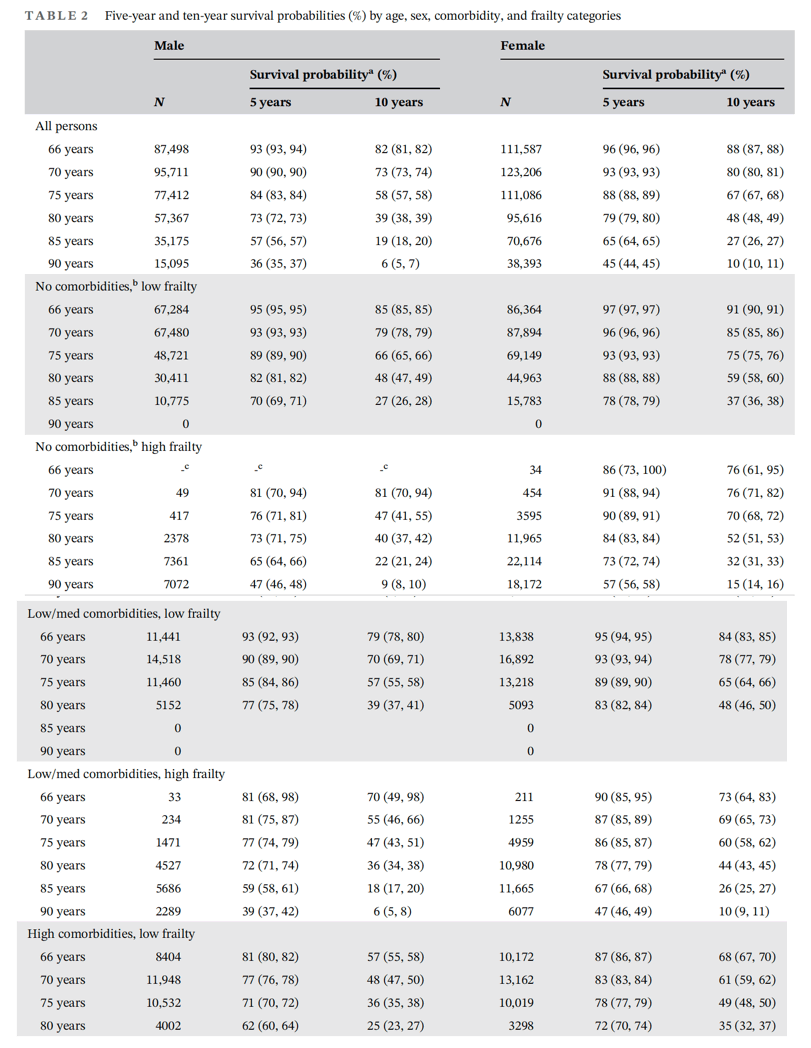
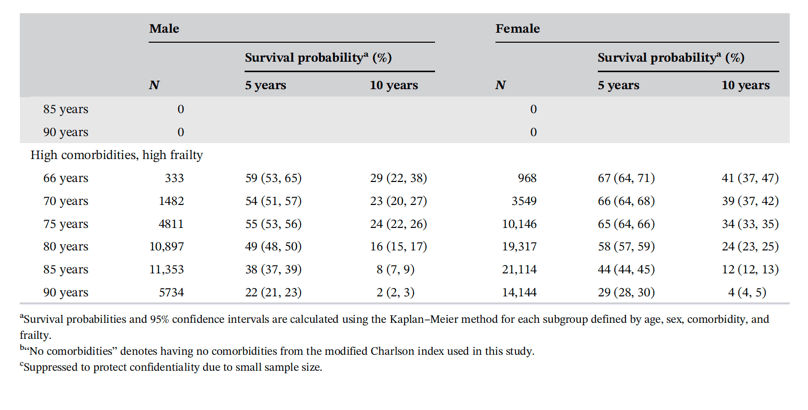
|
|
| |
| |
|
|
|